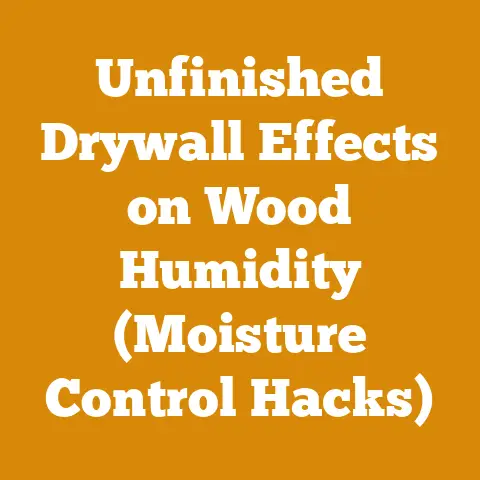Creosote Leaking from Stove Pipe (5 Critical Wood Stove Fixes)
Safety First: A Word of Caution Before We Begin
Before we dive into the nitty-gritty of diagnosing and fixing a creosote-leaking stove pipe, let’s talk safety.
Working with wood stoves, stove pipes, and potentially heights involves inherent risks.
Carbon monoxide poisoning is a serious threat.
Always ensure you have working carbon monoxide detectors in your home, especially near sleeping areas.
Wear appropriate safety gear, including gloves, eye protection, and a dust mask, particularly when cleaning or dismantling stove pipes.
Never work on a hot stove or stove pipe.
And if you’re uncomfortable with any part of this process, don’t hesitate to call a professional.
Your safety and the safety of your home are paramount.
I’ve seen too many near misses to not emphasize this point repeatedly.
Now, let’s get started.
Creosote Leaking from Stove Pipe: 5 Critical Wood Stove Fixes
Creosote.
It’s the bane of every wood stove owner’s existence.
I’ve personally battled this sticky, tar-like substance for years, both in my own home and while helping friends and neighbors maintain their wood-burning systems.
Creosote leaking from your stove pipe isn’t just messy; it’s a serious fire hazard.
This guide is designed to walk you through the most critical steps to identify the cause of the leak and implement effective fixes.
We’ll cover everything from understanding what creosote is to practical solutions you can implement today.
Understanding Creosote: The Silent Threat
Before we jump into fixes, it’s crucial to understand what creosote is and why it’s so dangerous.
Creosote is a byproduct of incomplete combustion.
When wood burns incompletely, the smoke contains unburned organic vapors, gases, and particles.
As this smoke travels up the relatively cooler stove pipe, these components condense and deposit on the inner surfaces, forming creosote.
There are three stages of creosote formation:
- Stage 1 (Flaky Creosote): This is the easiest to remove.
It’s typically dry and flaky. - Stage 2 (Granular Creosote): This is a more hardened, granular deposit.
It’s more difficult to remove than Stage 1. - Stage 3 (Glazed Creosote): This is the most dangerous.
It’s a hard, shiny, tar-like substance that’s extremely difficult to remove and highly flammable.
This is often what causes leaks.
The danger lies in creosote’s flammability.
Even a thin layer of creosote can ignite, leading to a chimney fire.
A chimney fire can quickly spread to your roof and home, causing catastrophic damage.
Creosote leaks indicate a significant buildup, meaning you’re at an elevated risk.
Key Terms:
- Incomplete Combustion: Burning wood without enough oxygen or at a low temperature, leading to the production of smoke containing unburned particles.
- Stove Pipe: The connector pipe between the wood stove and the chimney.
- Chimney: The structure that vents exhaust gases from the stove to the outside.
- Draft: The flow of air through the stove and chimney, which is essential for proper combustion.
- Seasoned Wood: Wood that has been dried to a moisture content of 20% or less.
- Green Wood: Freshly cut wood with a high moisture content (often above 50%).
Fix #1: Burning Seasoned Wood (The Foundation of Clean Burning)
This is the most fundamental fix, and frankly, the most important.
I can’t stress this enough: burning unseasoned wood is the #1 cause of creosote buildup. Green wood contains a significant amount of water.
This water needs to be evaporated before the wood can burn efficiently.
This evaporation process cools down the firebox and the stove pipe, promoting incomplete combustion and creosote formation.
Why Seasoned Wood Matters:
- Higher Burning Temperatures: Seasoned wood burns hotter, leading to more complete combustion.
- Reduced Smoke Production: Less moisture means less smoke and fewer unburned particles.
- Increased Efficiency: You get more heat from seasoned wood, meaning you use less wood overall.
How to Season Wood Properly:
- Split the Wood: Splitting wood increases the surface area exposed to air, accelerating the drying process.
I prefer using a hydraulic log splitter for larger rounds; my current model is a 25-ton splitter which has proven invaluable.
For smaller pieces, a maul or splitting axe works well.
Aim for pieces that are approximately 4-6 inches in diameter. - Stack the Wood Off the Ground: Use pallets or wooden beams to elevate the woodpile, allowing air to circulate underneath.
- Stack Loosely: Don’t pack the wood too tightly.
Leave space between the rows to allow for airflow.
A criss-cross stacking pattern works well. - Cover the Top: Protect the woodpile from rain and snow by covering the top with a tarp or roofing material.
Leave the sides open for ventilation. - Wait Patiently: Seasoning takes time.
Hardwoods like oak and maple typically require 12-24 months to dry properly.
Softwoods like pine and fir may dry faster, but generally aren’t the best choice for wood stoves due to their higher resin content. - Measure Moisture Content: Use a wood moisture meter to check the moisture content before burning.
Aim for a moisture content of 20% or less.
I use a simple pin-type meter that provides accurate readings.
Case Study: I once helped a friend who was struggling with excessive creosote buildup.
He was burning primarily green oak, which he had cut down just a few months prior.
After explaining the importance of seasoned wood, we spent a weekend splitting, stacking, and covering his woodpile.
The following winter, he burned only seasoned wood, and his creosote problems virtually disappeared.
The difference was night and day.
Strategic Advantage: Investing the time and effort into properly seasoning your wood is the single best investment you can make in the safety and efficiency of your wood-burning system.
Tools & Specifications:
- Hydraulic Log Splitter: 25-ton capacity (recommended for larger volumes of wood)
- Splitting Axe/Maul: 6-8 lb head weight (for smaller splitting tasks)
- Wood Moisture Meter: Pin-type or pinless meter (target moisture content: <20%)
- Pallets/Wooden Beams: For elevating woodpile
- Tarp/Roofing Material: For covering woodpile
Fix #2: Increasing Burn Temperature (Hotter Fires, Cleaner Burns)
Burning hotter fires helps to ensure more complete combustion, reducing creosote formation.
This doesn’t mean overheating your stove; it means maintaining a proper fire with adequate airflow.
How to Increase Burn Temperature:
- Use Smaller Pieces of Wood: Smaller pieces of wood burn hotter and faster.
- Increase Airflow: Open the air vents on your stove to allow more oxygen to reach the fire.
Experiment with different vent settings to find the optimal balance. - Top-Down Burning: Start the fire with kindling and smaller pieces of wood on top, gradually adding larger pieces as the fire progresses.
This method helps to establish a strong draft and promote hotter burning. - Avoid Dampers (If Possible): Dampers restrict airflow, which can lower the burn temperature and increase creosote production.
If your stove has a damper, use it sparingly. - Don’t Smother the Fire: Avoid piling wood on the fire in a way that smothers it.
Leave space for air to circulate.
Experience: I’ve noticed that a well-established coal bed is crucial for maintaining a hot fire.
Once the initial flames die down, the coals provide a consistent source of heat that helps to burn off any remaining smoke and vapors.
Strategic Advantage: Hotter fires not only reduce creosote buildup but also provide more efficient heating, saving you money on firewood.
Tools & Specifications:
- Firewood Processor: For consistent sizing of firewood (optional, but increases efficiency)
- Fire Poker: For arranging wood and coals to optimize airflow
Fix #3: Insulating the Chimney (Maintaining Draft and Preventing Condensation)
A cold chimney is a creosote factory.
When hot smoke enters a cold chimney, it cools rapidly, causing the unburned particles to condense and deposit as creosote.
Insulating your chimney helps to keep it warm, maintaining a strong draft and preventing condensation.
Types of Chimney Insulation:
- Chimney Liners with Insulation: These are the most effective way to insulate a chimney.
They consist of a stainless steel liner surrounded by insulation. - Chimney Wraps: These are less effective than liners but can provide some insulation.
- Pour-in Insulation: This type of insulation is poured into the space between the chimney and the surrounding masonry.
Benefits of Chimney Insulation:
- Improved Draft: A warm chimney creates a stronger draft, which helps to draw smoke and exhaust gases out of the stove.
- Reduced Creosote Buildup: Insulation prevents the chimney from cooling down too quickly, reducing condensation and creosote formation.
- Increased Efficiency: A well-insulated chimney helps to retain heat, improving the overall efficiency of your wood-burning system.
Technical Details:
- Chimney Liner Material: Stainless Steel (304 or 316 grade)
- Insulation Material: Ceramic Fiber Blanket or Vermiculite
- Insulation Thickness: 1-2 inches (depending on climate and chimney design)
Challenge & Solution: Installing a chimney liner can be a challenging DIY project, especially in older homes.
It often requires working at heights and maneuvering the liner through tight spaces.
If you’re not comfortable with this type of work, it’s best to hire a professional.
Strategic Advantage: Insulating your chimney is a long-term investment that will pay off in reduced creosote buildup, improved efficiency, and increased safety.
Fix #4: Regular Chimney Inspections and Cleaning (Prevention is Key)
Even with the best practices, some creosote buildup is inevitable.
Regular chimney inspections and cleaning are essential for preventing dangerous accumulations and ensuring the safe operation of your wood stove.
Inspection Frequency:
- At least once a year: Even if you don’t burn wood frequently, it’s important to have your chimney inspected annually.
- More frequently if you burn a lot of wood: If you burn wood regularly, you may need to have your chimney inspected and cleaned more often, perhaps every 3-6 months.
Cleaning Methods:
- Chimney Sweep: Hiring a professional chimney sweep is the most effective way to clean your chimney.
They have the tools and expertise to remove creosote safely and thoroughly. - DIY Cleaning: If you’re comfortable with heights and have the right tools, you can clean your chimney yourself.
This typically involves using a chimney brush to scrub the inside of the chimney.
Tools for DIY Chimney Cleaning:
- Chimney Brush: Choose a brush that is the correct size and shape for your chimney.
- Extension Rods: Use extension rods to reach the entire length of the chimney.
- Dust Mask and Eye Protection: Protect yourself from dust and debris.
- Drop Cloth: Cover the area around the stove to protect it from soot.
Personal Note: I always wear a respirator mask when cleaning my chimney.
The dust and soot can be quite irritating to the lungs.
Case Study: I once inspected a friend’s chimney and found a significant buildup of Stage 3 creosote.
He had been burning wood for years without ever cleaning his chimney.
We hired a professional chimney sweep to remove the creosote.
The sweep told us that the chimney was on the verge of a chimney fire.
This experience reinforced the importance of regular inspections and cleaning.
Strategic Advantage: Regular chimney inspections and cleaning are essential for preventing chimney fires and ensuring the safe operation of your wood stove.
It’s a small price to pay for peace of mind.
Fix #5: Stove Pipe Configuration and Maintenance (The Devil is in the Details)
The configuration and maintenance of your stove pipe play a significant role in creosote buildup and potential leaks.
Improperly installed or maintained stove pipes can create areas where smoke cools and condenses, leading to creosote formation.
Key Considerations:
- Proper Slope: The stove pipe should slope upwards from the stove to the chimney at a rate of at least 1/4 inch per foot.
This helps to ensure that smoke and exhaust gases flow smoothly up the chimney. - Minimize Horizontal Runs: Horizontal runs of stove pipe should be as short as possible.
Long horizontal runs allow smoke to cool and condense, increasing creosote buildup. - Proper Connections: All stove pipe sections should be securely connected with screws or clamps.
Loose connections can allow smoke to leak, creating a fire hazard.
I prefer using stainless steel screws for their durability and resistance to corrosion. - Regular Inspection: Inspect your stove pipe regularly for signs of damage, such as rust, cracks, or loose connections.
- Clean the Stove Pipe: Clean the stove pipe at least once a year, or more frequently if you burn a lot of wood.
This can be done using a chimney brush or a specialized stove pipe cleaning tool.
Troubleshooting Leaks:
- Check Connections: Start by checking all the connections between the stove pipe sections.
Make sure they are tight and secure. - Inspect for Rust or Corrosion: Rust and corrosion can weaken the stove pipe and create leaks.
Replace any sections that are damaged. - Look for Obstructions: Obstructions in the stove pipe can restrict airflow and cause smoke to back up, leading to leaks.
Remove any obstructions you find.
Original Insight: I’ve found that using a telescoping stove pipe section can make cleaning much easier.
You can simply remove the telescoping section and clean it separately.
Case Study: I once helped a neighbor who was experiencing creosote leaks from his stove pipe.
After inspecting the system, I discovered that the stove pipe had a long horizontal run with several loose connections.
We replaced the stove pipe with a shorter, more direct run and secured all the connections with screws.
The leaks stopped immediately.
Strategic Advantage: Proper stove pipe configuration and maintenance are essential for preventing creosote buildup, reducing leaks, and ensuring the safe and efficient operation of your wood stove.
Tools & Specifications:
- Stove Pipe: 24-gauge black steel or stainless steel
- Screws/Clamps: Stainless steel
- Chimney Brush: Appropriate size for stove pipe diameter
- Telescoping Stove Pipe Section: For easier cleaning (optional)
- Level: For ensuring proper slope
Additional Tips for Creosote Control
Beyond the five critical fixes, here are some additional tips to help control creosote buildup:
- Burn Hardwoods: Hardwoods like oak, maple, and birch burn hotter and cleaner than softwoods like pine and fir.
- Don’t Burn Trash or Treated Wood: Burning trash or treated wood can release harmful chemicals and increase creosote production.
- Install a Catalytic Combustor: Catalytic combustors are devices that are installed in wood stoves to reduce emissions and improve efficiency.
They work by burning off unburned particles in the smoke, reducing creosote formation. - Consider a EPA Certified Stove: Newer EPA-certified wood stoves are designed to burn more efficiently and produce less creosote.
Cost Considerations:
- Seasoned Wood: The cost of seasoned wood can vary depending on your location and the type of wood.
However, it’s generally more expensive than green wood. - Chimney Liner Installation: The cost of installing a chimney liner can range from $1,000 to $3,000, depending on the length of the chimney and the complexity of the installation.
- Chimney Sweep Services: The cost of hiring a professional chimney sweep typically ranges from $150 to $300.
- EPA Certified Stove: New EPA-certified wood stoves can range in price from $800 to $4,000.
Skill Levels Required:
- Burning Seasoned Wood: Beginner
- Increasing Burn Temperature: Beginner
- Insulating the Chimney: Intermediate to Advanced (may require professional assistance)
- Regular Chimney Inspections and Cleaning: Beginner to Intermediate
- Stove Pipe Configuration and Maintenance: Beginner to Intermediate
Next Steps:
- Assess Your Situation: Identify the specific causes of creosote buildup in your wood-burning system.
- Implement the Fixes: Start by implementing the most fundamental fixes, such as burning seasoned wood and increasing burn temperature.
- Schedule a Chimney Inspection: Have your chimney inspected by a professional to assess the extent of creosote buildup.
- Create a Maintenance Schedule: Develop a regular maintenance schedule for your wood-burning system, including chimney inspections, cleaning, and stove pipe maintenance.
- Stay Vigilant: Monitor your wood-burning system for signs of creosote buildup and adjust your practices as needed.
By following these steps, you can significantly reduce creosote buildup in your wood-burning system, ensuring the safety and efficiency of your home heating.
Remember, prevention is key.
A little effort upfront can save you a lot of trouble and expense down the road.
Stay safe and happy burning!






